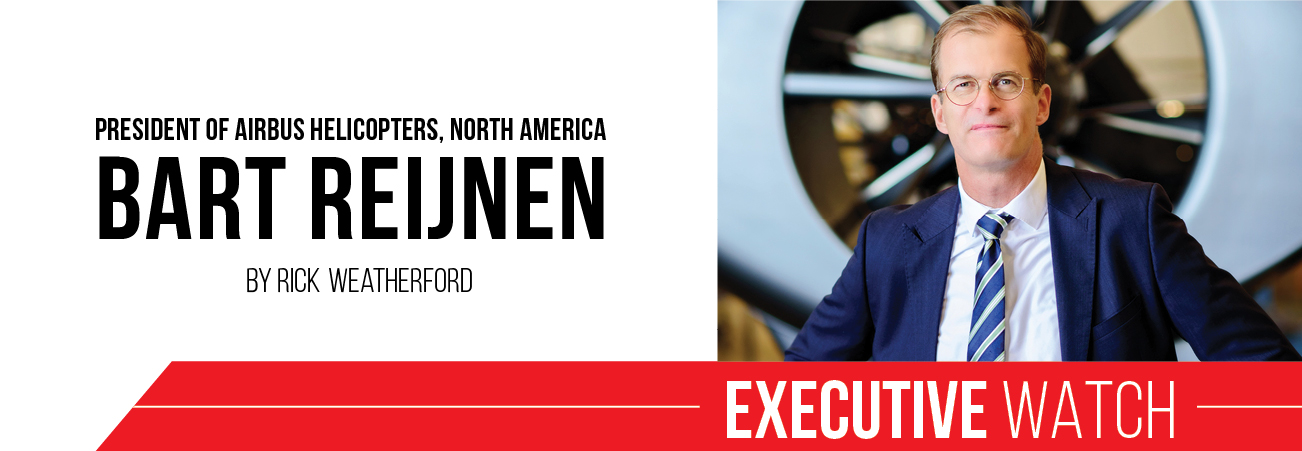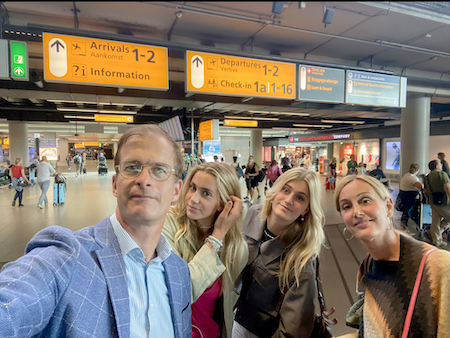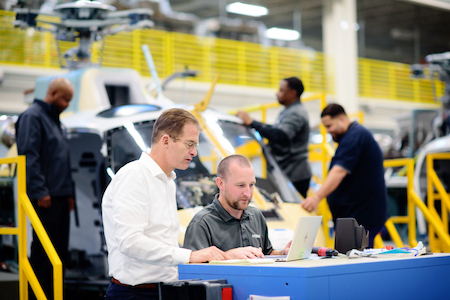|
Feb
23
2024
|
|
Posted 1 years 321 days ago ago by Admin
|
|

You’ve likely heard of famed aviation pioneer Antony Fokker, “The Flying Dutchman.” Well, Bart Reijnen could too be called “The Flying Dutchman,” as the native of the Netherlands has flown and lived all over Europe throughout his aerospace career. He also recently jumped over the pond late last year to land in Grand Prairie, Texas, where he has taken control as president of Airbus Helicopters Inc.-North America. By “aerospace career,” we mean just that: aero-space. Reijnen has worked in both ‘aero’ aircraft aviation both as an engineer and executive. He’s also worked in the ‘space’ space, playing a role in the ambitious Artemis program plan to return humanity to the moon by 2026.
In part, Reijnen’s eventful aerospace career is due to the strategic location of the small Dutch city of his youth: Roermond, located in the southern Netherlands, close to the borders of Belgium and Germany. Being in a border town, young Bart saw many military aircraft soaring overhead and dreamed of becoming a fighter pilot. That dream disappeared by his 17th birthday when he realized he was too tall to fit inside an F-16 fighter jet. “Yet, I still wanted to be involved with aircraft,” he said undeterred. So, he studied aerospace engineering with a specialty in flight dynamics, aircraft stability and control, at one of the world’s top-10 engineering and technology universities: the Netherlands’ Delft University of Technology.
This academic decision led to a key internship opportunity that launched his eventful career. Daimler-Benz Aerospace in Germany offered Reijnen an opportunity (along with three other students) to complete their final thesis work in Munich. Reijnen was also placed into Daimler-Benz’s corporate young managers program. He visited different corporate sites and engaged in various assigned projects. “It was a super interesting program that helped me learn about myself and how to effectively communicate at a very young age. It was a fantastic chance to grow,” he says. “In my college studies, it became obvious that I wanted to know a little bit about everything rather than specialize in one topic to its depth. So, when I was placed in that program and got to rub shoulders with executives across many areas, it was a natural fit and set the direction for my career.”
France
After his internship concluded in Germany, the direction Reijnen headed toward was to Toulouse, France. With his freshly earned Delft master’s degree, Reijnen started, in 1997 as a project management office manager at Airbus on what would eventually become the A380 passenger airliner. “It was a fascinating time and project because all over Europe and beyond, people in the industry were talking about how our European aircraft would be bigger than the Boeing 747,” he recalls. “It was a great time and place to be a young engineer.”
During that great time Reijnen was schooled (in a good way) by Jurgen Thomas, a senior German aerospace manager, known as the godfather of the A380 program. “He was a real engineer’s engineer and we don’t have those type of managers like him anymore,” Reijnen reminisces. “He always had a little Casio calculator he typed on to confirm computer models he was given. I asked him why he did that. He answered, ‘If their models are within 5% of what I get on my calculator here, they are right. If they are outside 5%, they are wrong.’ He regularly caught some errors and he taught me you have to really understand the figures you are working with. I remember that lesson to this day and emphasize it to my team.” Yet, as great as those Toulouse teachings were, by the year 2000, Reijnen had an important decision to make: “Did I want to stay in France or return to Germany to my girlfriend, Saskia?”

Germany
He chose well because three decades later Saskia is not only his wife, but mother to their two teenage daughters. He says, “Personally, I think we as parents have raised two daughters to a stage where we can say they’re on their way. They haven’t yet graduated, but we’re very proud of them and their accomplishments. I’m a proud dad of two lovely daughters.”
In addition to his family, the decision to go back to Deutschland, also worked out career wise. Reijnen became executive assistant/chief of staff to a foundational mentor, Rainer Hererich, at European Aeronautic Defence and Space Company (EADS). Reijnen says, “I had access to all the information he had while he was running the company. I sorted out the papers that came to him and pre-formulated responses that he would either approve, amend, or reject. I got to see how he thought: what he would do and why he did it. Over a couple of years of working with him, I developed such an intimate relationship with him to where he would come into my office and I knew what he was going to ask or say before he spoke. I was so young, not even a manager, but he let me learn from him. That relationship had prepared me to take my first CEO job.”
Netherlands
EADS believed that Reijnen was indeed ready and offered him the chance to return to his native land in 2006 as CEO of a fascinating small company that EADS acquired from the Dutch government, comprising the space activities of the bankrupt Fokker Aircraft Company. Known then as Dutch Space (now known as Airbus Netherlands), the acquired company manufactured sub-systems and equipment for satellites and launcher rockets. “I had no background in space or in building satellites, but leadership thought me being Dutch with good knowledge of the Group made me a good fit. Like in the past, I was given a fantastic opportunity and took it,” he says. “I was tasked with integrating Dutch Space into the big Airbus company. Yet, when we were able to closely look into the company after the sale (to EADS, which later became Airbus), it looked less rosy and involved turnaround management. We put a new strategy in place that made the company grow again that worked very well. We also successfully lobbied politicians in the Netherlands to increase their institutional budgets for space during that time. Our accomplishments with Dutch Space were a great achievement. I learned a lot during my seven-year term as CEO. I was still early in my career and gaining a lot of experience.”
Germany (again)
That experience prepared Reijnen for his next assignment. Airbus sent him to the “nice, old city” (as Reijnen describes it) of Bremen in North Germany, where he was put in charge of all human space flight and exploration at Airbus Defense and Space. “We had sites in Germany, France, and Houston, Texas, and it was very fascinating work,” he says. That allure included NASA’s Artemis program. Not only does this program plan to take humanity back to the moon by 2026 (“humanity,” means that this time the program astronauts include women, people of color, and internationals). The program’s goals include building a long-term moon base for manufacturing and research, as sustaining water has likely been detected in lunar craters. It’s the original Apollo program of the 1960s-70s on steroids with the ultimate goal of using the moon to get to Mars—and this century Uncle Sam invited friendly nations to actively participate. Reijnen explains, “The European Space Agency-ESA and Airbus are providing the service module and NASA and Lockheed Martin/SpaceX are manufacturing the capsule and rocket.” A 10-day lunar fly-by, Artemis 2, is pegged to launch in September 2025 when high-definition communications will be tested and sights searched for a suitable landing site on the moon’s south-pole region for Artemis 3’s crew to land on in late 2026.
Reijnen considers his role in this project as one of his proudest professional achievements. “Signing that contract with NASA and ESA for Airbus Defense and Space to develop the so-called service module to bring Americans back to the moon was a great achievement. It was the result of hard work by a big team around me, and I was proud to be a part of it.”
In 2016, Reijnen answered a phone call that would take him from outer space to Scandinavia for yet another adventure. Airbus leadership wanted to know if he was interested in being a CEO candidate for Satair, an Airbus services company, which is a global distributor of aviation spare parts based in Denmark. He explains his thinking at the time, “I was in my 40s and 10 years into the space business and I really loved it. We were in the forefront of innovation and working in a small, tight knit community in which there was much international collaboration. Yet, if I turned down opportunities like Satair, I would likely remain in the space sector for the rest of my career. I decided to make a change and took the opportunity to return to my aerospace roots.”
Denmark
Reijnen became Satair’s CEO. “Moving to Satair in Denmark was similar to when I became CEO of Dutch Space in the Netherlands. It was a somewhat independent subsidiary, but still part of Airbus and subject to all Airbus policies. I built bridges between Satair’s culture and customers to the Airbus company,” he says. “This is very similar to what I’m doing now at Airbus Helicopters-North America, where we are a separate legal entity with two regions (U.S. and Canada). Although we are North American, we are part of the larger Airbus. We need to take the best from both worlds; we serve the North American market as a local North American company and at the same time utilize the experience and large global resources of Airbus.”
Reijnen is proud of the culture he and his team created at Satair. “I’m particularly proud of the global culture that spans from Miami to Beijing. It is a mix of Airbus culture and Satair’s legacy culture; it’s an environment in which people are very happy to work.”
Surprisingly impressive is that Satair ultimately became a growth story, despite Reijnen’s reign there coinciding with COVID. Annual revenue increased from about $1.6 billion in the beginning of his stewardship to $2.7 billion last year when he left for Airbus Helicopters-North America to lead its over 1,100 employees.

United States of America
Reijnen has just moved to Airbus Helicopters headquarters in the Dallas/Ft. Worth metro area. (His family hasn’t even joined him yet from Europe because his daughter’s school year has not concluded.) Although he’s very early in his new role in a new industry to him, he already sees how his experience at Satair will directly help Airbus Helicopters throughout North America. “The whole industry is experiencing large supply-chain challenges and it’s something that will not be over tomorrow morning, but will carry far into 2024. Taking on this challenge is high on my priority list and is a high priority for my group. My experience during seven years at Satair was all about supporting worldwide airlines with spare parts,” he says. “My challenge in coming to Airbus Helicopters-North America is to listen very carefully to our customer’s expectations for the helicopters they have in service; and try to meet their expectations in light of ongoing supply-chain challenges. That will not always be easy, but we must certainly try. We need to get closer to our customers to understand their asks from their perspective as the ones actually operating the helicopter. (Reijnen says that one of his strengths is his ability to understand the perspective of others.) Innovation, technology, and data systems can help drive customer support in the field.”
Reijnen sees another priority. “We also need to make our company and our products more eco-friendly and more sustainable. Society is asking for that and rightly so, not only from our industry, but from all on a global level. The aerospace industry has an important contribution to make in this regard and we at Airbus want to stand strong and have a pioneering role in making our industry more sustainable. We cannot do it alone, but we want to be a leader.”
To lead, Reijnen expects his team to follow his example. “My personal values for myself are trust, teamwork, and transparency. These are my three values and what I ideally expect from my team that direct reports. I tell them this is what I expect.”
He not only tells them his expectations, he also gifts value-enforcing reading to his direct reports. You are the Team: 6 Simple Ways Teammates can go from Good to Great is the book he gave them this past Christmas. Of course, he’s read it, but Reijnen may not have found that book’s title as amusing as the title of a management book he was gifted by a colleague: Who Moved My Cheese? “I found that funny because we Dutch are very fond of cheese,” Reijnen remarks.
Reijnen also has a fourth fundamental trait he expects: “Accountability. It’s important to really take ownership of a topic and drive it to the end.” Yet, while his team’s values are uniform, that doesn’t mean that every member is the same. “For me ‘team’ does not mean a group of equals. For example, look at an American football team. They each have different roles and personalities, but in the end they need to play together as one,” he says. “My team needs a level of diversity, including diverse personalities; we should not be identical and all equal. On my last team, I had a member who was introverted and took a glass-half-empty point of view, yet all the rest of us were glass-half-full types. I could have been tempted to tell him to quit being so negative and quit bringing us down, but in essence he was helping bring us back down to reality. His contribution really helped us as a team. We win together and lose together as a team.”
Based on Reijnen’s travel record of racking up wins, expect another W in North America.
READ MORE ROTOR PRO: https://justhelicopters.com/Magazine
WATCH ROTOR PRO YOUTUBE CHANNEL: https://buff.ly/3Md0T3y
You can also find us on
Instagram - https://www.instagram.com/rotorpro1
Facebook - https://www.facebook.com/rotorpro1
Twitter - https://twitter.com/justhelicopters